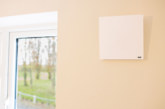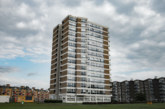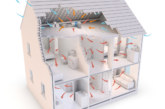Social housing providers are being urged to check there is sufficient ventilation on all new and refurbishment roofing work following the wider introduction of the Homes (Fitness for Human Habitation) Act. The advice comes from roof systems manufacturer Marley, who is warning that condensation damage could lead to landlords being prosecuted under the new legislation.
The Homes (Fitness for Human Habitation) Act was first introduced in March 2019 for tenancies that started or renewed after that date, but from the 20th March 2020 it has been extended to include all existing tenancies in England. This allows both private and social tenants to sue landlords for a number of defects, including damp and mould, in their homes if they are not fixed.
Condensation is a common cause of mould in rental properties and can be created by tenant behaviour, such as not using extractor fans in bathrooms or drying washing on radiators. However, Marley is warning that in some instances, insufficient levels of roof ventilation could also be a significant factor.

Tom Woodhouse, Site Services Manager at Marley, commented: “Today’s homes are far more energy-efficient, with increased levels of thermal insulation and airtightness. This means that without the right amount of roof ventilation, condensation may form in the roof space, causing damage to timber battens, rafters, fixings and insulation.
“If left unchecked, this build-up of condensation and moisture can be so severe that it penetrates the ceiling, causing damage to the rooms below. This can lead to damp and mould which not only has the potential to affect tenants’ health and cause expensive damage to the property, but under the new legislation, if it isn’t fixed, could result in legal action against the housing provider.”
Code of practice
BS 5250:2011+A1:2016 is the code of practice for control of condensation in buildings and all social housing specifiers should follow these guidelines. However, recently there has been some confusion about ‘fully breathable’ underlays, which may have led to insufficient ventilation levels in new homes.
Tom explained: “In our experience the term ‘breathable’ underlay is quite often misunderstood because it suggests that ventilation is not required. However, this is not the case as the British Standard, BS 5250, does not consider the situation where it is proposed to provide no ventilation to the roof void. As such, whatever type of underlay they are using, social housing specifiers should ensure they include some form of supplementary low- and high-level ventilation in accordance with BS 5250 to prevent the risk of condensation build up. They should also make sure that there are no gaps in insulation, which can increase the risk by creating cold spots, but make sure it does not block air flow from the eaves.”
Advice to social housing providers
Marley’s advice is that, as well the steps already being taken to educate tenants about reducing moisture build up, social housing providers should check pitched roofing specifications for all new and refurbishment building work to ensure there is adequate ventilation in line with BS 5250.
The manufacturer also recommends getting a new NBS specification specific to every project and use of a fully ventilated pitched roof system, to reduce risk and ensure the whole roof complies with BS 5250, BS 5534 and BS 8612. Marley’s full roof system comes with a free 15-year warranty for extra peace of mind.









